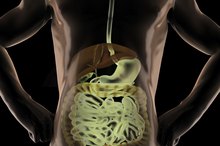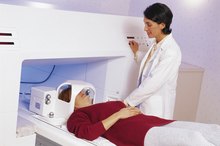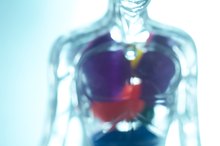How to Read an Ultrasound of the Liver
Ultrasound is a type of imaging that uses sound waves to produce a picture. This technology is used widely to help determine medical conditions and states, such as cirrhosis of the liver, heart conditions and the progression of pregnancy. Ultrasound is extremely accurate as different echoes form a shadow picture. For the liver, an ultrasound of the abdomen is performed 12.
Look at the video display. A transducer will be used to scan the body. It is placed over your abdominal region and sends high-frequency sound waves into the body. It then listens for the echo to bounce off the tissues and records an image on the screen. First, look at the image as a whole, getting an idea of the entire area.
Causes of Spots on the Liver
Learn More
Look at the specific organs showing on the display screen. You will see not only the liver but also the organs surrounding the liver, including the kidneys, intestines and gall bladder. Look at the liver close up. You will be able to examine the ultrasound referencing pain and abnormalities that you are aware of and examine the display screen for objects obstructing the liver or abnormal growths on or around the area of the liver.
Look for location and orientation. Ultrasounds are read from left to right 2. Recognize the difference between fluids and solids. A cyst is a fluid-filled sac. When a cyst has no debris, it appears on the display screen as black. When the sound waves travel through fluids, the results appear bright and white, Thus, a cyst filled with fluid would show as bright or white on the screen, creating your solids and fluids.
What Does a Pinched Nerve MRI Look Like?
Learn More
Look for poor-quality images. When traveling through fat and air, the sound waves do not produce a quality image. The liver is a blood-rich organ full of fluids and should appear clearly on the screen. You may notice stones or enlargement of the liver, or a poor image reading may be an indication of a pathology. Blood flow will be recognized by red and blue signals. This is called continuous Doppler. In most circumstances, red represents blood moving toward you and blue represents blood moving away from you.
Tips
Always ask your physician to explain the results of your ultrasound.
Warnings
If you are experiencing pain and liver ailment symptoms, such as jaundice, discoloration of the whites of your eyes or stomach bloating, schedule a visit with your physician.
Related Articles
References
Tips
- Always ask your physician to explain the results of your ultrasound.
Warnings
- If you are experiencing pain and liver ailment symptoms, such as jaundice, discoloration of the whites of your eyes or stomach bloating, schedule a visit with your physician.








